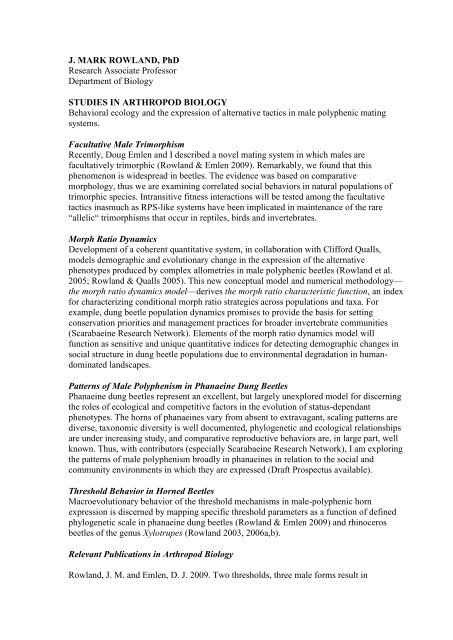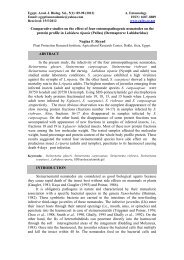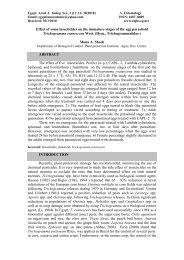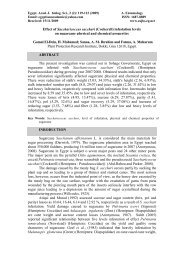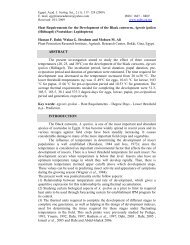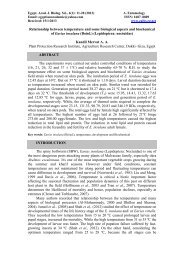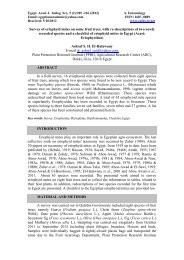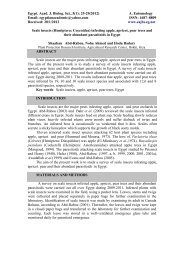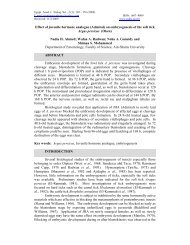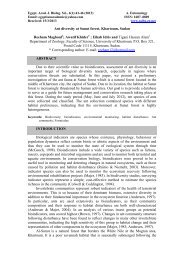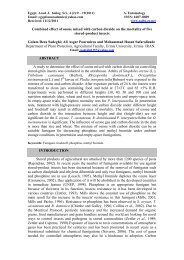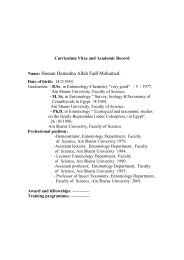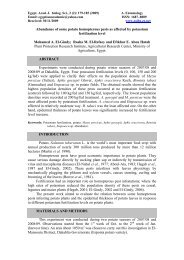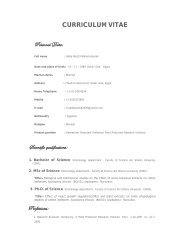J. MARK ROWLAND, PhD Research Associate Professor ...
J. MARK ROWLAND, PhD Research Associate Professor ...
J. MARK ROWLAND, PhD Research Associate Professor ...
You also want an ePaper? Increase the reach of your titles
YUMPU automatically turns print PDFs into web optimized ePapers that Google loves.
J. <strong>MARK</strong> <strong>ROWLAND</strong>, <strong>PhD</strong><br />
<strong>Research</strong> <strong>Associate</strong> <strong>Professor</strong><br />
Department of Biology<br />
STUDIES IN ARTHROPOD BIOLOGY<br />
Behavioral ecology and the expression of alternative tactics in male polyphenic mating<br />
systems.<br />
Facultative Male Trimorphism<br />
Recently, Doug Emlen and I described a novel mating system in which males are<br />
facultatively trimorphic (Rowland & Emlen 2009). Remarkably, we found that this<br />
phenomenon is widespread in beetles. The evidence was based on comparative<br />
morphology, thus we are examining correlated social behaviors in natural populations of<br />
trimorphic species. Intransitive fitness interactions will be tested among the facultative<br />
tactics inasmuch as RPS-like systems have been implicated in maintenance of the rare<br />
“allelic“ trimorphisms that occur in reptiles, birds and invertebrates.<br />
Morph Ratio Dynamics<br />
Development of a coherent quantitative system, in collaboration with Clifford Qualls,<br />
models demographic and evolutionary change in the expression of the alternative<br />
phenotypes produced by complex allometries in male polyphenic beetles (Rowland et al.<br />
2005; Rowland & Qualls 2005). This new conceptual model and numerical methodology—<br />
the morph ratio dynamics model—derives the morph ratio characteristic function, an index<br />
for characterizing conditional morph ratio strategies across populations and taxa. For<br />
example, dung beetle population dynamics promises to provide the basis for setting<br />
conservation priorities and management practices for broader invertebrate communities<br />
(Scarabaeine <strong>Research</strong> Network). Elements of the morph ratio dynamics model will<br />
function as sensitive and unique quantitative indices for detecting demographic changes in<br />
social structure in dung beetle populations due to environmental degradation in humandominated<br />
landscapes.<br />
Patterns of Male Polyphenism in Phanaeine Dung Beetles<br />
Phanaeine dung beetles represent an excellent, but largely unexplored model for discerning<br />
the roles of ecological and competitive factors in the evolution of status-dependant<br />
phenotypes. The horns of phanaeines vary from absent to extravagant, scaling patterns are<br />
diverse, taxonomic diversity is well documented, phylogenetic and ecological relationships<br />
are under increasing study, and comparative reproductive behaviors are, in large part, well<br />
known. Thus, with contributors (especially Scarabaeine <strong>Research</strong> Network), I am exploring<br />
the patterns of male polyphenism broadly in phanaeines in relation to the social and<br />
community environments in which they are expressed (Draft Prospectus available).<br />
Threshold Behavior in Horned Beetles<br />
Macroevolutionary behavior of the threshold mechanisms in male-polyphenic horn<br />
expression is discerned by mapping specific threshold parameters as a function of defined<br />
phylogenetic scale in phanaeine dung beetles (Rowland & Emlen 2009) and rhinoceros<br />
beetles of the genus Xylotrupes (Rowland 2003, 2006a,b).<br />
Relevant Publications in Arthropod Biology<br />
Rowland, J. M. and Emlen, D. J. 2009. Two thresholds, three male forms result in
facultative male trimorphism in beetles. Science 323:773-776. [article PDF] [supplemental<br />
materials PDF]<br />
Rowland, J. M. 2006a. Continued revision of the systematics of rhinoceros beetles of the<br />
genus Xylotrupes (Scarabaeidae, Coleoptera). Privately published. Albuquerque. 49 p.<br />
Rowland, J. M. 2006b. Partial revision of the systematics of rhinoceros beetles of the genus<br />
Xylotrupes (Scarabaeidae, Coleoptera). Privately published. Albuquerque. 41 p.<br />
Rowland, J. M, and Qualls, C. R. 2005. Likelihood models for discriminating alternate<br />
phenotypes in morphologically dimorphic species. Evolutionary Ecology <strong>Research</strong> 7:421-<br />
434. [PDF]<br />
Rowland, J. M., Qualls, C. R., Beaudoin-Ollivier, L. 2005. Discrimination of alternative<br />
male phenotypes in Scapanes australis (Boisduval). Australian Journal of Entomology<br />
44:22-28. [PDF]<br />
Rowland, J. M. 2003. Male horn dimorphism, phylogeny and systematics of rhinoceros<br />
beetles of the genus Xylotrupes (Scarabaeidae, Coleoptera). Australian Journal of Zoology<br />
51:213-258. [PDF]<br />
ACADEMIC OVERVIEW<br />
Doctorate in zoology from the Department of Biology, Texas Tech University. Graduate<br />
research concerned the biology of an early-derived group of terrestrial arthropods.<br />
Postdoctoral positions in the Department of Pharmacology and Therapeutics at the TTU<br />
Health Sciences Center and with the Glaucoma Section of the National Eye Institute. As<br />
postdoc, discovered profound endogenous component for sympathetic regulation of ocular<br />
hydrodynamics in mammals. As Visiting Assistant <strong>Professor</strong> at TTUHSC, awarded RO1<br />
funding to investigate the role of the mammalian circadian system in regulating aqueous<br />
humor formation and intraocular pressure as a model for therapeutic intervention in<br />
primary open-angle glaucoma. Took dual positions as <strong>Research</strong> <strong>Associate</strong> in the<br />
Department of Ophthalmology at Yale University and as Senior <strong>Research</strong> Scientist of<br />
Ocular Projects at CIBA Corporation. Our team patented two drugs for ophthalmic<br />
indications, one of which answered a largely unmet therapeutic need, reached market and<br />
$24M contribution in 1994. At UNM have held academic title as <strong>Associate</strong> <strong>Professor</strong> in the<br />
Division of Ophthalmology, and <strong>Research</strong> <strong>Associate</strong> <strong>Professor</strong> in the Department of<br />
Biology. At UNMHSC conducted clinical research on the etiology of glaucomatous field<br />
defects in diabetes, and on an endogenous component for central regulation of ocular<br />
hydrodynamics in normotensive humans.<br />
J. Mark Rowland, <strong>PhD</strong><br />
Department of Biology<br />
MSC03 2020<br />
1 University of New Mexico<br />
Albuquerque, NM 87131-0001<br />
Email: rowland@unm.edu<br />
Tel: 505/823-9320


